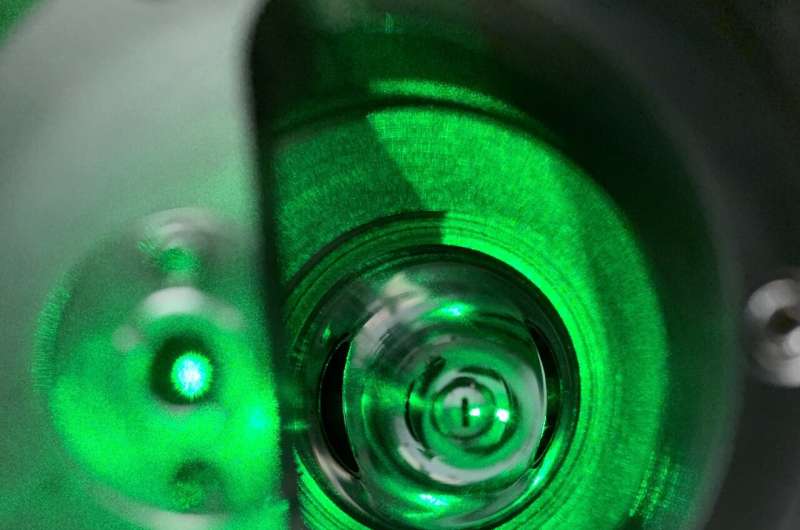August 18, 2022 feature
A precise measurement of the neutral weak form factor of Ca-48

The CREX Collaboration, a large group of researchers from different universities worldwide who are involved in the Calcium Radius Experiment (CREX), has recently collected a precise measurement of the broken mirror symmetry in the elastic scattering of longitudinally polarized electrons in 48Ca which is a signature of the nuclear weak force. Their measurement allowed them to determine the difference in the distribution of neutrons and protons within the 48Ca nucleus. Their experiment was performed at the Thomas Jefferson National Accelerator Facility (JLab), in Newport News, Virginia.
"The experiment we conducted is very challenging, as the weak interaction is a faint whisper of an effect in the scattering of electrons from nuclei, which is dominated by the electric charge of the electron and protons in the nucleus," Kent Paschke, one of the researchers who carried out the study, told Phys.org. "The fact that the weak interaction breaks mirror-symmetry, and that weak interaction is much stronger with neutrons than with protons, makes this measurement possible."
The idea of measuring the neutron distribution in nuclei using the weak interaction in electron scattering has been around for decades. However, the need to collect this measurement has recently become more pressing, due to improvements in the scientific understanding of nuclear structures, while experimental techniques improved to help bring this idea to fruition.
"Since electron-nuclear scattering is dominated by the electromagnetic interaction, to even see the effect of the weak interaction one needs to look at something that only the weak interaction can do," Paschke explained. "The weak interaction, alone among the known fundamental forces, does not respect mirror symmetry, so we can see its effect in the difference in scattering rate between configurations that are mirror images of each other."
The recent work by Paschke and his colleagues is based on new experimental techniques for collecting high-precision measurements. In their experiments, the researchers specifically collected their measurements using a polarized electron beam.
"An electron, polarized along its direction of motion, elastic scattering at some specific angle from an unpolarized nuclear target, is an exact mirror-image of the same scattering but with the electron spin reversed, pointing opposite to its direction of motion," Paschke said. "The effect of the weak interaction in the scattering process was measured as the change in the scattering rate when flipping the beam polarization to be along or against the beam direction."

The effect probed by Paschke and his colleagues is incredibly small. In their experiments, they measured an elastic scattering rate that was larger or smaller by only 2.7 parts per million, or 0.00027%, depending on the spin of the electron. To precisely measure such a small difference, the researchers observed more than 100 trillion elastic scattering events. They also had to be sure that nothing else had changed while they flipped between configurations.
"This form factor can be interpreted to provide the thickness of the 'skin' of weak charge around the nucleus, that is, the excess of the average radius of the sphere of weak charge compared to that of the electromagnetic charge," Paschke said. "Since weak charge is predominantly neutrons, this can also be interpreted as the neutron skin of Ca-48, that is, the radius of the neutron distribution minus the radius of the proton distribution."
The measurement collected by Paschke and his colleagues shows that the neutron skin of Ca-48 is smaller than what most theoretical models had predicted. This suggests that the equation-of-state (i.e., an equation describing the change in binding energy vs density), is softer than expected, so the energy cost of a neutron-rich nucleus being at higher density is smaller than some had thought.
When analyzing their observations, the CREX Collaboration found that they were aligned with some theoretical calculations. Nonetheless, their finding sets new constraints on existing theoretical models, particularly in terms of the neutron skin of Ca-48.
"Our findings get even more interesting when we compare this result to the result we released last year, for a similar measurement with the much heavier Pb-208 nucleus," Paschke said. "That result implied a significantly thicker skin for Pb-208 than was expected. Nuclear structure models tend to suggest that these results should be correlated—a thin skin in one system should be a thin skin in the other system. In this way, the contrast between the two measurements is a bit surprising and provides a challenge to the theoretical description of nuclei."
The new measurement collected by the CREX Collaboration is extremely straightforward to interpret, with minimal and widely established theoretical corrections. This means that their measurement method is a valuable way of probing this poorly constrained degree-of-freedom in nuclear structures.

"The measurements we collected are very difficult to attain, so in the end the precision of the measurements leaves significant wiggle room for the models," Paschke said. "There are several modern models that are consistent with everything else we know about nuclei, while being only in mild tension with our results. That is, some models disagree with the central value of our measurements, but only by an amount that can be reasonably explained by the intrinsic precision of our experimental results."
Essentially, while the researchers' results do not disprove existing nuclear theory, they place new important constraints on it. In addition, the experimental methods they developed could be used for future studies.
"The methods we used to control, characterize, and correct for variations in the beam trajectory were shown to be more precise and robust in the Pb-208 measurement than in any prior measurement," Paschke said.
To collect their measurements on Ca-48, the CREX Collaboration used two complementary techniques that allowed them to detect the beam polarization with an unprecedented level of precision. In the future, these techniques could be used to measure the weak interaction in the electron scattering with high levels of precision.
"Significantly improving the precision with either the Pb-208 or Ca-48 nuclei would be very exciting, but it would be difficult for to improve upon these measurements at this facility," Paschke said. "We really have pushed the technique at JLab about as far as it can go. There are some plans for making measurements with a dedicated apparatus the new MESA facility being built in Mainz, and it is very important to explore that opportunity."
Some of the members from the CREX Collaboration are now working on new, high-precision experiments at JLab. Their present efforts specifically focus on searching for new fundamental interactions beyond the standard model.
"The MOLLER experiment will also start taking data in a few years, using techniques refined by these Ca-48 and Pb-208 measurements, to achieve an unprecedented sensitivity to new physics in the interaction between two electrons," Paschke added.
More information: Precision determination of the neutral weak form factor of 48Ca. Physical Review Letters(2022). DOI: 10.1103/PhysRevLett.129.042501.
Accurate determination of the neutron skin thickness of 208Pb through parity-violation in electron scattering. Physical Review Letters(2021). DOI: 10.1103/PhysRevLett.126.172502.
Journal information: Physical Review Letters
© 2022 Science X Network




















